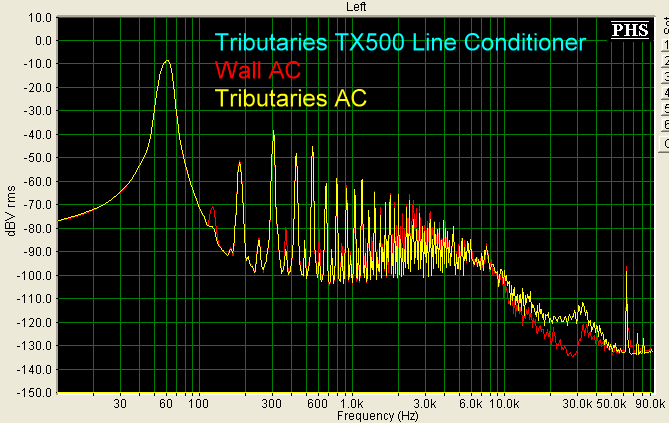Introduction
It is amazing that we get such good
performance from our hi-fi equipment when the incoming AC is so dirty,
meaning that it has noise up the kazoo from our refrigerators, air
conditioners, light controllers, RF from the miles and miles of wiring to
reach our house, and other things.
Topping that off is the fact that you don't
get just a 60 Hz (50 Hz in other parts of the world) sine wave on your
voltage. It is full of harmonics (about 4% THD+N).
In other words, your house AC power is garbage
in relation to what it should be.
Enter the world of the AC Line Conditioner (Power Conditioner,
Power Manager).
There are many types. Filters, balanced
transformers (they act like a huge inductor that low-passes the 60 Hz),
units that insert and subtract small voltages from the waveform to get it
back to a sine wave, and units that convert the incoming AC to DC, then
re-create the 60 Hz sine wave from scratch.
As they get more complex, they get more
expensive.
The most basic type has a series of filters
that remove some of the harmonics from the wall AC signal. Such is the
design of the Tributaries TX500.
The Design
The TX500, priced at $750 retail, has three
sets of filters, one set to two outlets, one set to one outlet, and the
third set to the last two outlets. One filter is connected to each leg (+
and -).

Click on the
photo above to see a larger version.
So, looking at the rear panel, you can see
that there is one outlet assigned to "Analog", two to "Digital", and two to
"Amplifiers". They are numbered 1 through 5, which corresponds to five LEDs
on the front panel that light up when the unit is powered on. If your wall
socket is wired incorrectly (hot and neutral reversed), a Polarity Fault LED
on the panel will illuminate.
Outlets 1 and 2 are always on, when the unit
is plugged in. When you press the On button, outlet 3 comes on immediately,
then outlet 4 comes on 5 seconds later, and outlet 5 comes on 5 seconds
after that. So, you get sequenced turn-on. This is useful when you have big
power amplifiers that have current rush at power on. Otherwise, you may trip
your circuit breakers.
When you push the On/Off button to turn it
off, outlets 5, 4, and 3 turn off in reverse sequence, 5 seconds apart.

You can program the sequence to your
preference with a series of dip switches seen in the upper left corner of
the photo.
The only nit I have with the TX500 concerns
the layout of the LED indicators on the front, in relation to the rear. I
usually put such products on the rack, then plug components into them by
reaching over the front. The outlets numbering on the rear is reversed from
the front. In other words, LED 1 is on the left on the front panel, but
outlet 1 is on the right on the rear panel, when leaning over the unit to
plug something in. No big deal though, once you are aware of this.
Like all line conditioners, the TX500 has
surge protection. In this case, the protection is provided not only for the
hi-fi components, but your telephone system and cable TV system. There are
phone jacks and cable TV jacks on the rear panel for this purpose.
Protection is delivered via Silicon Avalanche Diodes (SAD), rather than
Metal Oxide Varistors (MOV). SADs recover fully after a surge rather than
deteriorating after each surge, as MOVs do.
Lastly, there are trigger jacks so you can
turn the TX500 on simply by turning on your preamplifier or processor. The
power on sequence would then turn on your power amplifiers.
There is a voltmeter on the front panel if you
want to see what your incoming AC voltage is.
Performance
The TX500 is one of the nicer line
conditioners I have used over the years. I used the trigger out from a
Lexicon MC-12B SSP to turn on the TX500, which then turned on a McIntosh
MC602 stereo power amplifier (600 watts per channel). I plugged the MCD201
into outlet 2 (always on) and the MC602 into outlet 4.
In my experience, line conditioners have more
of a beneficial effect on mass market equipment, like receivers, than they
do on high performance products. That is because mass market components tend
not to have very robust power supplies.
That was the case here, as I could not discern
any audible difference with the TX500. However, that does not diminish its
surge protection value (a lightning strike would cook my expensive
components just as much as it would any mass market receiver), nor its value
in sequential power-on. However, this would be a very good product to use
with any mass market setup, in that every bit of noise reduction will
benefit the sound.
Speaking of noise reduction, here is a graph
showing the harmonics present in my wall AC vs. the harmonics in the AC
coming out of the TX500.

Notice that the second, sixth, and tenth
harmonics are reduced, as well as some peaks between 1 kHz and 8 kHz. The
reduction in some peaks is 10 dB, which is a lot. Like
some other line conditioners I have tested, noise between 10 kHz and 50 kHz
is actually increased. I have never figured out why that is, but it is
there, for sure. Fortunately, power transformers in components down the line
act like inductors, which low-pass and help filter out high frequency noise.
Conclusions
The Tributaries TX500 does its job. Harmonics
from incoming 60 Hz AC are reduced, and reduction is always good. This
product also has sequenced power-on, which I value highly, and surge
protection for all of your expensive hi-fi components, as well as telephones
and cable TV boxes.
- John E. Johnson, Jr. -